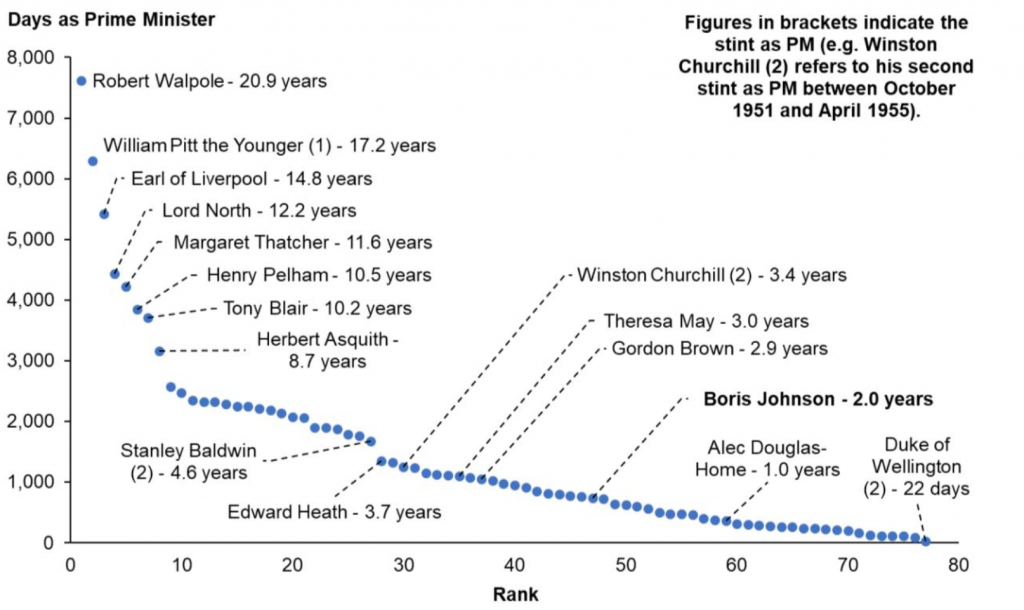MIND THE GAP: HOW LONG WILL BORIS JOHNSON SERVE AS PRIME MINISTER?

Source: Wikipedia – data tables can be viewed here.
Serving as Prime Minister for a long time does not guarantee that history will remember you kindly. But I suspect most who reach the summit of politics are keenly aware of their place in the longevity league table.
The chart above shows the length of time served as Prime Minister for each of the 77 individual stints. They can be grouped into three broad categories:
1) The also-rans: 50 stints of less than four years ranging from the 22 days of the Duke of Wellington’s second stint to the 3.7 years served by Ted Heath.
2) The solid performers: 19 stints ranging from 4.6 years (Stanley Baldwin’s second stint) to 7.0 years (Marquess of Salisbury’s third stint).
3) The high achievers: Eight stints ranging from Herbert Asquith’s 8.7 years to the 20.9 years served by Robert Walpole. The gradient is noticeably steeper for this group.
Obviously, the total tenure of the likes of the Marquess of Salisbury (13.7 years) and William Gladstone (12.3 years) puts them in the upper echelons too. However, I think individual stints are of more interest to us given that once Boris Johnson ceases to be Prime Minister, he is unlikely to come back (famous last words!).
Johnson recently passed the two-year point of his premiership. This means he is already ranked 47th out of 77 in terms of individual stints as Prime Minister. And if he is still Prime Minister this time next year, he will have entered the top half of the table, overtaking Gordon Brown and Theresa May in the process.
What I find interesting about the league table is the gap of 319 days between Baldwin (second stint) in 27th and Heath in 28th. It may have something to do with the electoral cycle, though it’s worth remembering that before the 1911 Parliament Act, a parliament could run for seven years.
The government is currently in the process of repealing the 2011 Fixed-term Parliament Act, which states that the latest the next general election can take place is 2 May 2024. I think it’s safe to assume that the next election will be no later than this. Were Johnson to remain Prime Minister until then, he would slot in above Baldwin. Alternatively, he may be tempted to call an election in 2023. He must reach 8 April 2023 to equal Ted Heath, so a May 2023 election would at least get him to the top of the also-rans were he to be defeated.
Either way, if Johnson contests a May election in 2023 or 2024, then that gap in the list is unlikely to get all that much smaller. Perhaps it’s just a fluke that there’s quite a big gap, but I’m inclined to think that if Johnson makes it to 2023 and doesn’t call an election, then he’ll be PM at the election in 2024. The Tories have a reputation for being ruthless, but they let Major lead them into the 1997 election.
If Johnson contests and wins the next election, then he “only” needs to serve until May 2026 to overtake David Lloyd George, David Cameron, Clement Attlee, John Major and Harold Macmillan. If I had to guess when he leaves Number 10, I’d go for July 2026 just after we’ve celebrated the England football team winning the World Cup.
Tom Leveson Gower
Tom Leveson Gower is a longstanding poster and posts as TLG86